 Weird Stuff
Weird Stuff  Weird Stuff
Weird Stuff  Mysteries
Mysteries 10 Tragic Disappearances and Deaths in Joshua Tree National Park
 History
History 10 Ways Childhood Really Sucked in the Old West
 Music
Music 10 Name Origins of Famous Bands from the 1990s
 Religion
Religion 10 Biggest Turnarounds by the Catholic Church
 Weird Stuff
Weird Stuff 10 Unbelievable Times Laws Had Unintended Consequences
 Humans
Humans Ten Historic Women Who Deserve Way More Credit Than They Got
 Movies and TV
Movies and TV 10 Films That Spawned Major Lawsuits
 History
History Ten Times Towns Were Wiped Off the Face of the Earth
 Creepy
Creepy 10 of the Most Disturbingly Haunted Public Houses in the UK
 Weird Stuff
Weird Stuff 10 Niche Subcultures That Are More Popular Than You Might Think
 Mysteries
Mysteries 10 Tragic Disappearances and Deaths in Joshua Tree National Park
 History
History 10 Ways Childhood Really Sucked in the Old West
Who's Behind Listverse?

Jamie Frater
Head Editor
Jamie founded Listverse due to an insatiable desire to share fascinating, obscure, and bizarre facts. He has been a guest speaker on numerous national radio and television stations and is a five time published author.
More About Us Music
Music 10 Name Origins of Famous Bands from the 1990s
 Religion
Religion 10 Biggest Turnarounds by the Catholic Church
 Weird Stuff
Weird Stuff 10 Unbelievable Times Laws Had Unintended Consequences
 Humans
Humans Ten Historic Women Who Deserve Way More Credit Than They Got
 Movies and TV
Movies and TV 10 Films That Spawned Major Lawsuits
 History
History Ten Times Towns Were Wiped Off the Face of the Earth
 Creepy
Creepy 10 of the Most Disturbingly Haunted Public Houses in the UK
10 Infamous Cases Of Stigmata
Christianity thrives around the world. People devote their entire lives to a being they cannot see, touch, or feel. They run purely on faith. There are some faithful servants, however, who endure the ultimate mark of their religion. Seen as blessed, these people bear the wounds of Christ’s crucifixion—the stigmata.
Many believe stigmata to be a blessing to the holiest of servants, those saints among men who’ve been touched by Christ. Skeptics, on the other hand, believe that it is merely a medical problem, self-harm, or other explainable malady. The world may never truly know how stigmata appears on the bodies of those chosen, but each case is a parable of interest.
10 St. Catherine De Ricci
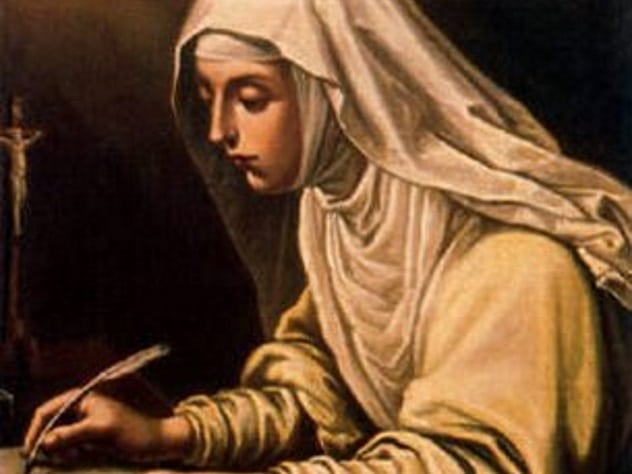
St. Catherine de Ricci (baptized as Alexandrina) was born in Florence, Italy, in 1522. Long before her time as a saint, Catherine showed great dedication to the Catholic religion. As a small child, she showed a great interest in prayer, and at a mere six years of age, her father placed Catherine in a convent with her aunt, Louisa De Ricci. At 14, she was chosen as mistress of novices and then as perpetual prioress at 25.
That all seems pretty normal for the life of a saint, but things took a turn when St. Catherine started up with her ecstasies of passion. From 1542 to 1554, every Thursday and Friday, Catherine would go into a trance in which she would experience the events of Christ’s passion and would “act out” those events. During this time, St. Catherine also experienced the stigmata. She would show bloody wounds on her hands, feet, and head, depicting the crucifixion. With the power of the stigmata and the intensity of St. Catherine’s passions of Christ, she passed into a mystical marriage with Jesus, and in 1542, she was given a ring to symbolize that she was a bride of Christ.
As her “mystical marriage” and stigmata continued, revelers would come from far and wide to see St. Catherine during her passionate moments, but people were so disturbed by her stigmatic wounds and her behaviors during her flights of ecstatic passion that they finally quit coming to see her.[1] Wouldn’t you know it, when the crowds stopped coming, so did the stigmata and the passions. Apparently being blessed with the stigmata only comes when the crowds are big and devout!
9 Father James Bruse
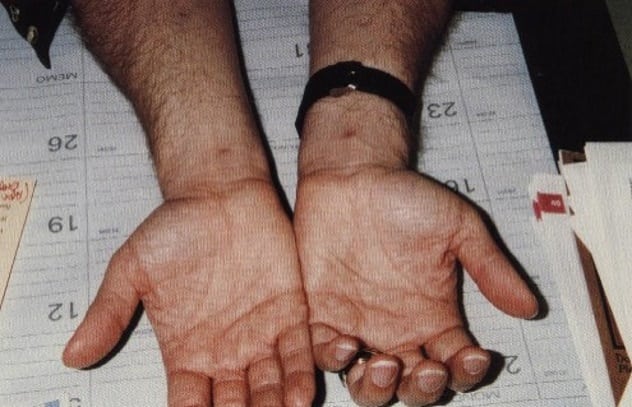
There have only been three known stigmatic priests in the 20th century, and Father James Bruse is one of them. Bruse’s journey into the world of stigmatics began in November 1991, when while at his parents’ home, he realized that their religious statues would weep water from their eyes when he entered the room. It began with just one statue, Our Lady of Grace, and then any religious statue he was around would begin to weep; it is thought by Bruse and his followers that thousands of statues wept in his presence.
The day after Christmas of the same year, however, Bruse knew something was changing in his spiritual life. He began to complain of sharp pains in his wrists. Shortly after he experienced this pain, blood began to seep from the unbroken skin on his wrists, feet, and his right side. Bruse had been “blessed” with the stigmata, the wounds of Christ. Along with his newfound stigmatic marks, Bruse also claimed to be able to heal, both spiritual and physically. The stigmata brought him the power to patch up the people in his congregation, but more importantly to Bruse, the influence of the stigmata brought him the power to bring more people back to the church.
Though the stigmata, for Bruse, had great power and allowed him to be on a higher level spiritually, the Diocesan Chancery in Virginia did not make any claims about the authenticity of the stigmata, and because there wasn’t an obvious religious message attached to Bruse receiving the stigmata, they were not willing to put out any ecclesiastical declarations about the situation.[2] Was it an elaborate hoax to bring in believers, or was it a real case of stigmata? If the Diocese can’t make a claim to its authenticity, neither can the average Joe.
8 Natuzza Evolo
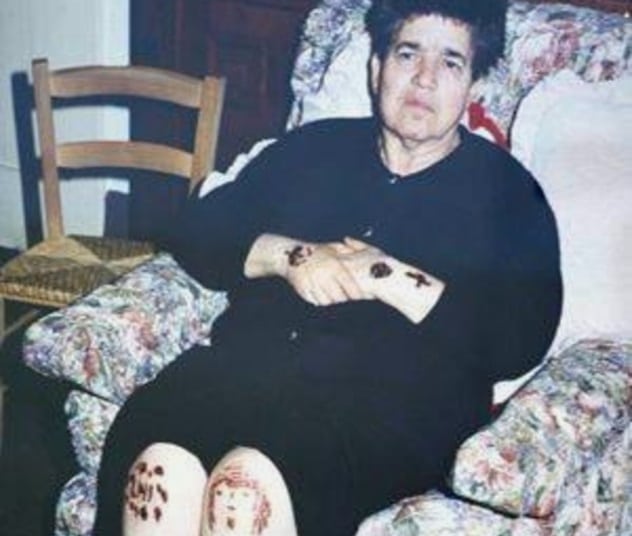
Natuzza Evolo was born in Calabria on August 23, 1924. Born into a fatherless family wrought with poverty, Evolo and her siblings were known locally as bastard children. Poverty kept Evolo from school, and she was illiterate her entire life. Often described as a “serene child,” Evolo began praying to the Virgin Mary at an early age for relief from her strife. At six years old, she was given the “gift” of being able to see Jesus, the Virgin Mary, angels, and saints. Her pastor at the time, though impressed by the gift the child had received, told her to keep all this information to herself for her own safety. In 1934, Natuzza’s mother was arrested, and she and her siblings were cast out by the landlady. With nowhere to sleep or stay safe, Evolo prayed to the Madonna to keep her safe and find her shelter. Apparently, while praying, Evolo heard a voice say, “Courage! I will find you a place to live.” A few days later, she was safe and sound in a communal dwelling.
Things in Evolo’s life got a bit more spiritual in the years to come. Throughout her life, she still spoke with Jesus and the Virgin Mary, but she was also afflicted with the markings of Christ; the stigmata ravaged her body and made her painful and bloody every Friday and through the entirety of Lent. During those times, she would lock herself away because the pain from the stigmata was too much for her to bear.[3] Her stigamatic wounds were very profound in that they had the ability to produce hemography, or writing produced by blood. Starting at age 16, Evolo would experience writing and symbols being produced from the blood which wept from her stigmata wounds. Any linen, garment, or other material that touched her weeping skin would come away with markings that were always Christian in nature. Many wanted their own pieces of hemography from Evolo, but they could never be produced on the spot. This “miraculous” writing ability took place on and off during her entire life until her death in 2009.
The power of her blessing of stigmata, as well as her talks with Jesus and His mother, were compounded by the fact that they gave Evolo the power to heal. She could apparently look directly at a person and thoroughly diagnose what was causing their ailments, using correct medical terminology. Evolo would then tell them how to cure themselves. If healing wasn’t good enough, Evolo could also tell the future and spoke languages she had never heard before. Remember that Evolo was illiterate; how could someone with no formal training know multiple languages but not be able to read or write? She never accepted money for her work and had many devout followers. Today, she still has devotees who worship her via her Immaculate Heart of Mary, Refuge of Souls Foundation, which she established during her life. Miracle worker or fantastic hoaxer? Her devotees believe in her powers, while doubters are unsure. The secret died with Evolo.
7 Marie Rose Ferron
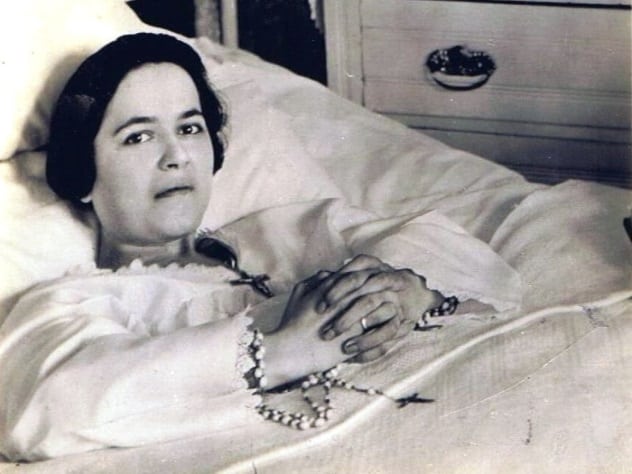
Marie Rose Ferron, known lovingly in history as “Little Rose,” was born on May 24, 1902, in Quebec, Canada. At age three, her family moved to the United States, taking up residence in Massachusetts. She is the first documented person in the United States to bear the markings of the stigmata. Rose, along with her other 14 siblings, were all dedicated to one of the mysteries of the rosary by their mother. Prophetically, Rose was dedicated to the crucifixion of Christ. By six years of age, Rose was already very pious and was seeing visions of the Child Jesus. At seven, Rose was taught, by Jesus himself, a French prayer that she said every day until her death. At 13, Rose became ill, and her hand and foot became paralyzed. The Holy Spirit pulled through again for Marie, as she took holy water one morning after mass, and her hand instantly worked perfectly. Sadly, the holy water only helped with her hand, and she had to remain on crutches for nearly 12 years.
Beginning at age 24, Rose began experiencing Christ’s pain as well as stigmata. In 1926, the stigmata of flagellation appeared as lashings on her back. In 1927, the stigmatic odds were raised, as Rose began to show the crucifixion marks of Christ, weeping marks on her hands and feet. In January 1928, Christ’s crown of thorns was starting to make its mark on Rose’s head. August 1929 marked the first time that Rose cried tears of blood from her eyes. Rose stopped displaying signs of the stigmata on August 1, 1930, but the pain she felt rose to its highest intensity. She suffered crippling agony, and her stigmata wounds would turn purple and ooze an unidentified serum.
It was around this time that rumors began to circulate that all her wounds were faked and that her pain was a hoax. Even many family members turned against Rose. Her spiritual advisor at the time, Father Joseph Baril, even told Rose that her spiritual life was built on “false foundations,” and she began to believe that she was possibly deceived by some illusion. Through her stigmatic time and then afterward while being considered a fraud, Rose was constantly in contact with Christ. She asked Him once, during one of her ecstasies, how much longer it would be until she met Him in Heaven. He told her she would die at age 33.
In April 1936, just a month before her 34th birthday, Rose began to show increasingly intense symptoms: first fainting, followed by the inability to eat or drink and a headache so intense that she was unconscious frequently. Lastly, Rose went deaf and blind. She died on May 11.[4] She almost missed the 33-year mark set by Jesus. Was this girl a true stigmatic plagued with ecstasies of the strife of Christ, or was she the fraud that everyone thought she was at the end of her life? Illusion or fact, Rose’s life was one for the religious books.
6 Zlatko Sudac

Zlatko Sudac was born in 1971 in Vrbnik on Krk island, Croatia. He served in the Yugoslav army in his younger years, and in 1993, he began studying for Roman Catholic priesthood. Within five years, Sudac was ordained a diocesan priest and started serving the community in Krk. After being instated as a priest, Sudac found himself busy with parish life, and nothing seemed amiss until the next year, when things took an unexpected turn.
On April 7, 1999, Sudac received the first mark of the stigmata. It took the form of a cross “imprinted” deeply on his forehead. Concerned for Sudac, his bishop sent him to a clinic in Rome. He remained here for 40 days, and he was tested and investigated intensely. Though it was not concluded that the mark was of divine origin, the hospital and doctors explained that there was no medical reason behind the marking of the cross on Sudac’s forehead. Nearly a year after the cross imprinted on his forehead, Sudac was marked again, this time by true stigmata markings. On October 4, 2000, Sudac received the wounds of Christ on his feet, wrists, and side. Coincidentally, this is the same day of the feast of St. Francis of Assisi—the first known stigmatist.[5]
Along with his stigmata, the power of mysticism flows in the body of Sudac. It is claimed that Sudac has the gift of illumination, the reading of souls, the odor of sanctity, and bilocation, which is the act of being in two places simultaneously. Being young and bearing the stigmata, Sudac has followers all over the world. People line up for days to attend his masses. Church officials are quoted as saying, “No church is big enough for Sudac now.” People are intrigued and mystified by Sudac’s stigmata, and they clamor to churches to view him. Ironically, Sudac doesn’t show his stigmata marks during his masses . . . which seems to be the reason devotees are showing up in the first place.
Until 2010, Sudac was a retreat leader at Beathany Retreat House on the Island of Losinj. Along with being a priest and stigmata bearer, he also has an affinity for art and creates pieces for churches and private homes. Stigmata and art; devotees and money. These are apparently matches made in Heaven.
5 Padre Pio Of Pietrelcina

Francis Forgione, later known as Padre Pio and then Saint Pio, was born May 25, 1887, in Pietrelcina, Italy. His parents entrusted his life to St. Francis of Assisi, which is why he was baptized as Francis the day after his birth. Apparently a disruptive baby, Francis would cry endlessly. His father, frustrated by the continuous crying, is quoted as saying, “It seems like the Devil has been born in my house.” From that point on, Francis never cried like that ever again.
A member of a deeply religious family, Francis spent much time at the Church of Saint Mary of the Angels; he was baptized, received his first communion, and was confirmed there. A young, pious child, he saw an apparition of the Sacred Heart of Jesus at a mere five years of age. He told Francis then that he would be His follower for life. Dedicating his life at that age marked him forever, and Francis began having visions of the Virgin Mary, which would continue his entire life. A busy five-year-old, Francis also made a deal with his guardian angel, with whom he could communicate to follow all the missions of God.
At the age of 16, Francis entered the novitiate of the Capuchin Friars, and he took the Franciscan habit and the name Brother Pio. He took his vows on January 27, 1907, and became an ordained priest on August 10, 1910. In September of the same year, he was sent to the friary of San Giovanni Rotondo, where he remained until his death in 1968.
In 1910, Padre Pio first started receiving the marks of the stigmata. He wrote a letter to his spiritual director at the time discussing the “red stains” in the middle of his hands accompanied by “intense pain.” These wounds and pains came and went, leaving Padre Pio with only the memory of the marks. The stigmata was not through with Padre Pio, however. After having his heart experience transverberation, or the lance of love, the stigmata made its appearance again—and this time for good. A month after experiencing the transverberation, Padre Pio received his first visual markings of Christ’s passion. Padre Pio described the occurrence of the stigmata in great detail in a letter to his director. He recounted a great light blinding him and Christ bleeding from him internally. Rays of light came out of his feet, hand, and side. After the vision had ended, he found himself upon the floor with the bleeding wounds. Through the pain, he prayed hymns of gratitude to God.
His fellow Capuchins, marveled by the appearance of Christ’s passion, had religious medical professionals examine Padre Pio. They decided that the marks were definitely of divine origin.[6] People became obsessed with Padre Pio and his stigmata. They flocked from all over the world to gaze upon him and his newly acquired abilities. After receiving the stigmata, Padre Pio could perform miracles. He was an avid healer of the masses and, in many instances, was claimed to be able to levitate. However, his popularity became a concern for the church, and they limited access to Padre Pio for a time. More investigations were done to confirm the authenticity of the stigmata. In 1934, years after the church came to terms with his stigmata and his fame, it let Padre Pio assume his duties again.
Though canonized and revered as a saint, Padre Pio is still touted as a fraud. Historian Sergio Luzzatto released a book entitled Padre Pio: Miracles and Politics in a Secular Age, which has information from the Vatican archives which supposedly proves Padre Pio had acquired and maimed himself with carbolic acid to produced his stigmata wounds. These allegations are nothing new where Padre Pio is concerned, as two successive popes thought he was a religious fraud and the stigmata a hoax. A real spiritual marvel or a well-prepared hoaxer? The texts of the religious say one thing, those of historians another. Padre Pio is a saint with a suspicious history.
4 St. Gemma Galgani
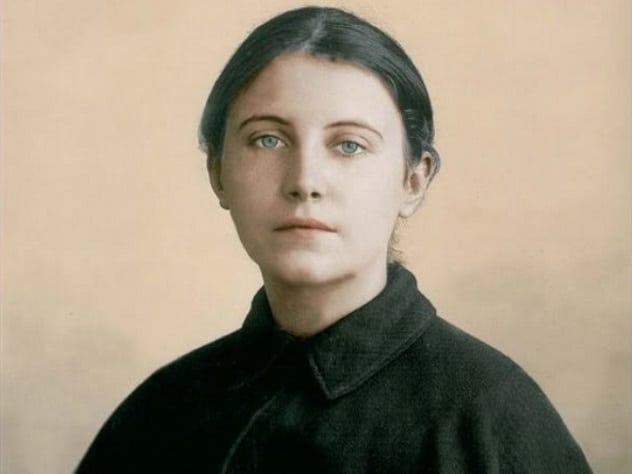
St. Gemma Galgani was born on March 12, 1878, near Lucca, Italy. Inspired greatly by her devoutly religious mother, Galgani developed an intense love for Jesus at an early age. At a mere eight years old, she lost her mother, and her father sent her to a Catholic boarding school, which Galgani described as paradise.[7] She received her first communion at nine, which was earlier than most. She spoke of her meeting with Jesus at the time and said that no one could understand the impact He made on her soul.
On June 8, 1899, after receiving communion, Galgani experienced her first religious ecstasy in which the Virgin Mary appeared, opened her dress, and wrapped Galgani in it. This was the beginning of her religious experience with spiritual beings. That same day, Galgani received the stigmata. Galgani claims that Jesus came to her with all His wounds open, but instead of blood, she saw flames. The flames then reached from Jesus and touched her, marking her hands, feet, and heart with the passion wounds. Blood poured from the wounds, and the pain was intense. But luckily, Galgani was apparently assisted to bed that night by her guardian angel and the Virgin Mary.
Though the stigmata is a blessed thing to many, Galgani was of poor health and said that she couldn’t deal with it. Her priest told her to pray the wounds away, and it apparently worked, leaving only the scars that would remain with her until her death. Galgani died of tuberculosis at age 25. Known for her patience and gentility, along with her blessed markings, Galgani was made a saint. Of the many cases of stigmata, Galgani’s account, though still very supernatural, was one of humility. She wanted it to go away; she didn’t flaunt it as so many others had. Does this add to the credibility of her account?
3 Therese Neumann
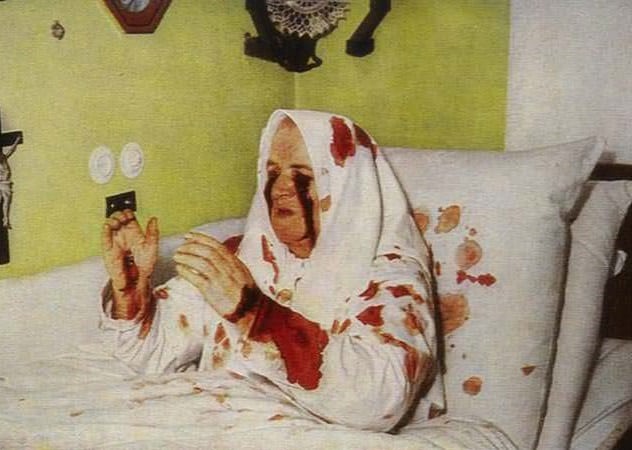
Therese Neumann was born in 1898 in Konnersreuth, Bavaria, and was the oldest of ten children. Being the eldest child, she was often put in charge of taking care of her siblings, especially after her father was called to serve in World War I. But taking care of children wasn’t her first calling; Therese’s true ambition was to become a missionary sister in Africa. Sadly, in 1918, she was injured during a fire, causing her to suffer partial paralysis of the spine and later blindness. The formerly hearty girl was left bedridden and unable to work. Since she couldn’t work, she took up the next best thing: intense religious devotion. Therese was especially enamored with St. Therese of Lisieux.
While lying in her bed on May 17, 1925, Therese heard the voice of the newly canonized St. Therese of Lisieux. She asked her if she wanted to be better, and Therese, of course, answered, “Yes!” The saint told her she could now stand and see, but she’d still suffer. And suffer she did—because Therese was about to get the shock of her life and receive the stigmata. On the first day of Lent in 1926, while ill with the flu, she was alone in her room when she experienced a divine ecstasy. As the day went on, she discovered bloody marks on her nightgown on her side and above her heart. The stigmata had chosen her. The side wound continually wept blood, and on the third day of Lent, the hand wounds appeared, followed by tears of blood the next day. St. Therese of Lisieux said she’d suffer, and it did not stop. Later in the year Neumann finally received her bloody crown of thorns.
The wounds never healed, and they stayed on Therese’s body until her death. Dealing with the stigmata is bad enough, but St. Therese of Lisieux came to Neumann during her suffering time and told her, “No more earthly food, you’ll survive on the Eucharist.” It is claimed that after this, Therese didn’t eat anything other than the Holy Eucharist every day and drank no water from 1926 onward.[8] Given that Therese lived until 1962, being a stigmatic is apparently a very thirsty job.
2 Teresa Musco
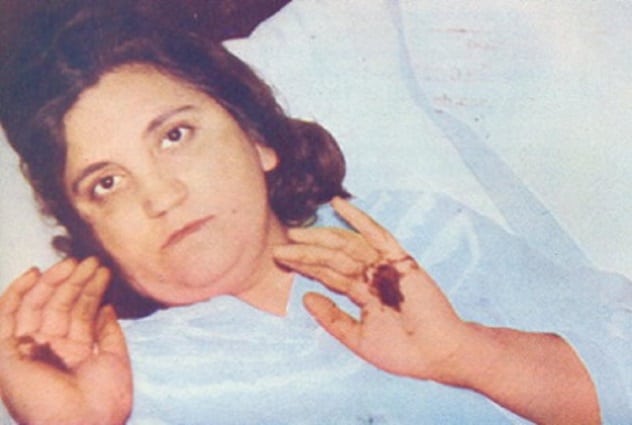
Teresa Musco was born in Caserta, Italy, on June 7, 1943. Growing up with an abusive father and during the chaotic time of World War II, Musco and her family were often left without food, necessities, and moral guidance. However, Teresa proved stronger than the rest; she was often called mature for her age and was extremely devoted to Jesus and prayer. At age five, Teresa had her first vision of the Virgin Mary. After having been struck by her father, Teresa saw the Virgin Mary come to her and explain that her father meant no harm from the beating. The Virgin Mary apparently condones child abuse.
The Virgin Mary continued to visit Teresa regularly, but then another player came in—Jesus. Jesus asked her if she loved Him, and Teresa answered yes. Jesus then said, to Teresa personally, that “He loved her so much that He would be willing to be crucified again just for her.” Apparently, holy figures really loved Teresa, for in 1950, Teresa was visited by Padre Pio, and he told her she’d one day look like him and then proceeded to show Teresa his stigmatic wounds.[9]
Years of hardship and pain continued to plague Teresa, but she maintained her devout lifestyle and her love of Jesus. In October 1968, however, Teresa wept because of pain in her hands and feet. Alone in her room, a tall man entered unexpectedly and said, “I shall leave you my wounds. Do you want to follow me?” Teresa again exclaimed “yes,” and that when she was spiritually crucified. On Holy Thursday 1969, the Virgin Mary came to her all in black and told Teresa, “My beloved son desired to give you His wounds.” At that point, Teresa had a full-blown stigmata episode, complete with bloody hands and feet and a deep pain in her heart. She then went into an ecstatic state and awoke from it bearing the marks of the crown of thorns, which she supposedly took from Jesus firsthand during her ecstatic episode.
Bearing the stigmata for years, Teresa was also prone to causing statues and holy pictures to weep blood. Teresa claimed that the sin of humanity was too much to bear and caused her great sadness, which was reflected in the weeping effigies. Teresa suffered her whole life, in both the natural and supernatural realm. Apparently, since Jesus was her super-affectionate friend, He came to her and told her that she would suffer no more and that He was taking her away from this world. Teresa and Jesus decided she would leave the world at 33 years of age. August 19, 1976, Teresa succumbed to her illnesses at the time and did die at the prophesied age. Was Teresa actually visited by various holy entities, or was her troubled, hardship-riddled life to blame for her visions?
1 St. Francis Of Assisi
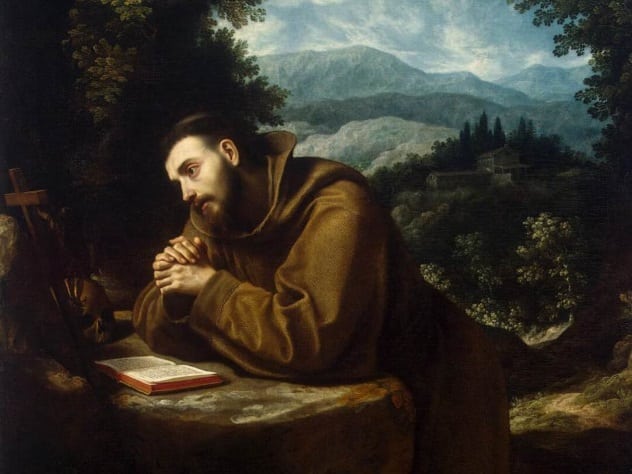
St. Francis is the poster child for the stigmata. He was the first ever to receive this “blessing,” and people have been following in his bloody footsteps for eons. Though a saint now, Francis was a wild sinner in his early life. Born in Italy in 1181, St. Francis was well-known for his extreme drinking and his penchant for partying.
After fighting in a battle between Assisi and Perugia, St. Francis was imprisoned for ransom for a year. During this time of imprisonment, you guessed it: He started receiving visions from God. According to legend, after he was released, Christ told St. Francis to devout himself to Him, repair the Christian church, and live a life of poverty.[10] St. Francis then abandoned his frivolous life and became a devotee of the faith, preaching and teaching all over the Christian world. He remained a pious devotee for as long as he lived, maintaining his poverty and living the life of an ultra-Christian.
In 1224, he made the ultimate sacrifice to devotion by undertaking a journey and fasting. He left to climb Mt. La Verna for a 40-day fast. One day during his fast, near the feast of the Exaltation of the Cross, a six-winged angel allegedly appeared to St. Francis while he prayed. The angel, as observed by St. Francis, bore the wounds of crucifixion. On September 14, St. Francis received the first marks of stigmata, having the sacred wounds appear on his hands, feet, and sides. These wounds stayed on and bled continually for two years, up until his death.
It is a simple tale, but some believe that this first case of stigmata can actually be traced back to disease. St. Francis suffered from many ailments during his lifetime. Historian Dr. Edward Frederick Hartung even diagnosed St. Francis with a debilitating eye disease known trachoma. Besides the eye infection, it is also believed that St. Francis’s stigmata was due to a severe case of malignant malaria, which causes hemorrhaging of blood through the skin in a medical condition known as purpura. Strangely enough, purpura is usually distributed symmetrically on the hands and feet. Sounds a lot like the stigmata, right?
We will never know what St. Francis was actually suffering from during his life. Whatever it was, it was painful and eventually led to his death two years later. He set the bar for stigmata, and people have been joining the stigmatic legions for years. Do they all have malaria, or are they all divine? The mystery remains.
Hi! I’m Theta! I am a full-time librarian with a penchant for writing, animals, and all things obscure.
Read more about Christian miracles and the debate over their explanations on 10 Biblical Miracles With Alternative Explanations and 10 Awesome Biblical Miracles.








